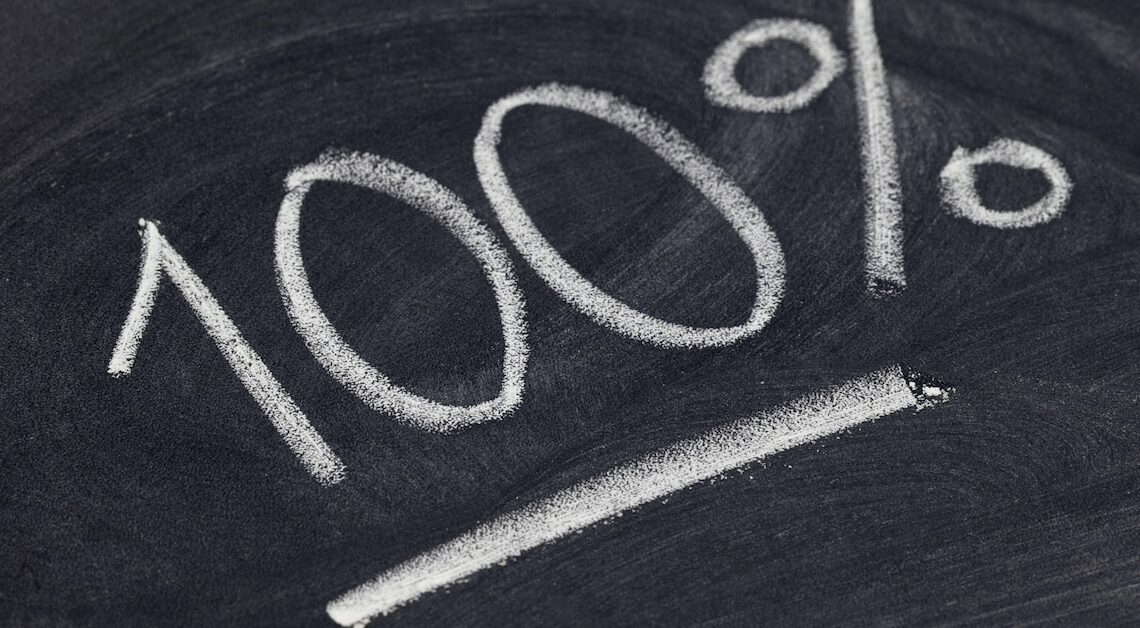
The percentage expresses a proportion in relation to a whole. Once you understand what percentage is, you can easily calculate it.
How do you calculate the percentage?
The percentage from mathematics is used to express a certain proportion in relation to a whole as a percentage. For example, if you take half of a pizza, you are taking 50% of that pizza. You come across the percentage everywhere in everyday life, for example when you get a discount on something. As a result, calculating percentages is a useful skill. Mathematics is not that difficult once you understand it through simply explained math books.
- Share of 100: The percentage always refers to a share of 100%. It is easily illustrated by expressing the percentage in the context of a ratio equation.
- Example: A pizza with 10 slices corresponds to 100%. 5 pieces correspond to half, i.e. 50%. Put in relation, it looks like this: 5 / 10 = 50% / 100% (5 is to 10 like 50% is to 100%). You can also write the slash as a fraction bar, it means nothing other than “divided by”.
- Calculation percentage: But what percentage of the pizza do you eat if you take 4 slices? The ratio is: 4 / 10 = p% / 100% (i.e. 4 is to 10 as p% is to 100%; p is unknown). Using the mathematical method of the rule of three, you can now calculate an unknown 4th value from 3 given values of a ratio.
- You want to calculate p, so you have to convert the equation to p. You do this by making the counter operation “divide by 100”. With “times 100” you get the 100% on the other side of the equation. This is common practice in mathematics.
- The equation is then: 4 / 10 * 100% = p%. Now p stands alone and can be calculated. If you calculate p, it comes out to 40%. For 4 out of 10 pizza slices, take 40% of the pizza.
Percentage formula
Nothing other than the ratio equation 4 / 10 * 100% = p%, rearranged above, expresses the formula for the percentage.
- The formula is: p = W/G * 100. The variable p is the percentage (i.e. the searched p%), W is the percentage value (i.e. the 4 pizza slices) and G is the basic value (the 10 pizza slices). So 10 pieces are the base and 4 pieces are the portion of it.
- If you insert the values into the formula, you get the same result, i.e. 40%. However, if you calculate using the ratio equation, you do not need to remember the formula.
- Another example: You will receive a 75 euro discount on your purchase of 250 euros. Now you want to know what percentage discount that is. Expressed as a ratio: €75 / €250 = p% / 100%. Now calculate “times 100” again, convert the equation to p and get the formula for the percentage: p % = €75 / €250 * 100%. Of all things, that’s a 30% discount on your purchase.
- If you would like to calculate the percentage even faster than using the rule of three, you can simply do this using percentage calculation using a Windows calculator or percentage calculation in Excel.
Other percent calculations and examples
You don't always have to calculate the percentage. Sometimes you may also want to know how much money a 30 percent discount represents. Especially with more expensive products such as B. a vacuum robot or a hot air fryer, discounts are interesting. Or you would like to find out how much the goods previously cost if they are now 30% cheaper. The ratio equation and the rule of three can also help you with this. You don't have to remember a formula or even a formula triangle for everything. (If necessary, you can quickly find out the price increases in the supermarket using this calculator, for example.)
- Example percentage value searched: Based on the example above, a product has a price of €250, but you get a 30% discount. How much is this discount in euros? The ratio equation is: W / €250 = 30% / 100%. (W is wanted and to 250 € it is like 30% to 100%.) Now rearrange the equation so that W stands alone and can be calculated.
- To do this, you need to do the opposite operation to “divide by”, namely “times”, and get the €250 to the other side of the equation. Rearranged, the equation then reads: W = 30% / 100% * €250. Do the math. The 30% discount corresponds to a percentage of €75. (You can see from the example above that you calculated correctly.)
- Example basic value wanted: A product that now costs €75 has been reduced by 30%. You would like to know how much it cost beforehand. The ratio equation is: €75 / G = 30% / 100%. This time, however, G is in the denominator of the fraction. So you can't just “calculate” the counter operation so that G stands alone.
- The good thing about a ratio equation is that you can easily reverse the ratio, i.e. numerator and denominator, as long as you do it on both sides of the equal sign. So: G / €75 = 100% / 30%. Now you can easily calculate “times 75 €” so that G stands alone.
- Consequently: G = 100% / 30% * €75. The solution is €250. The product, now priced at €75, originally cost €250 without the 30% discount.
- Extra note: Instead of p for the percentage, W for the percentage value or G for the basic value, you can simply use x as the variable you are looking for. It doesn't matter how you name the number you're looking for. It is important to change the ratio equation according to this desired variable x.
